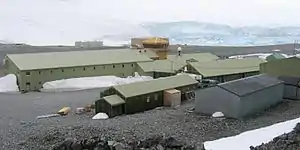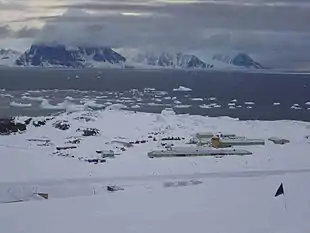Rothera Research Station
The Rothera Research Station is a British Antarctic Survey (BAS) base on the Antarctic Peninsula,[2] located at Rothera Point, Adelaide Island. Rothera also serves as the capital of the British Antarctic Territory, a British Overseas Territory.
Rothera Research Station | |
|---|---|
 | |
 Flag | |
.svg.png.webp) Rothera Research Station location within the British Antarctic Territory in Antarctica | |
 Rothera Research Station Location of Rothera Research Station in Antarctica | |
| Coordinates: 67°34′06″S 68°07′33″W | |
| Country | |
| British Overseas Territory | British Antarctic Territory |
| Location in Antarctica | Adelaide Island |
| Administered by | British Antarctic Survey |
| Established | 1975 |
| Elevation | 4 m (13 ft) |
| Population | |
| • Total | Summer: 100 Winter: 22 [1] |
| Type | All-year round |
| Period | Annual |
| Status | Operational |
| Website | www.antarctica.ac.uk |



History and current activities
Rothera station was established in 1975 to replace Adelaide station (1961-1977)[3] where the skiway had deteriorated.
The opening of the Bonner Laboratory in 1996/1997 marked the start of new activities in biological sciences in the Antarctic peninsula. These included scuba diving and experiments conducted in the Bonner Laboratory throughout the year. The first Bonner Lab burned down in the winter of 2001 after an electrical fault; it was rebuilt and opened in December 2003. Meteorological research using satellite data intercepted at the Rothera ground station also continues year round.
In January 2017, it was announced that the Rothera Research Station will receive £100m in funding from the government. The money will be used by the British Antarctic Survey to build new living quarters, storage and a new wharf. Tim Stockings, its director of operations called the investment “an exciting moment for polar science”. A portion of the money will also be used to fund the modernisation of facilities and buildings at the British Antarctic stations in Signy, Bird Island and at King Edward Point.[4]
Fieldwork is concentrated in the summer months from November until March. Once in the field, the parties travel using snowmobiles and sledges for up to four months, and, being in daily HF radio communication with Rothera, they can be resupplied when necessary by air.
The station is open throughout the year with a maximum population of 130 in the summer and an average winter population of 22.
Rocket science
In 1998, 26 sounding rockets of "Viper"-type were launched from Rothera Research Station. They reached altitudes of 100 kilometres (over 60 mi).[5]
Buildings at Rothera
Rothera has evolved from a small base (in its first winter it housed only four people) to the large complex it is today. As is the case everywhere in Antarctica, the buildings need constant repair, and eventual renewal, as the harsh environment takes its toll. Although some of the buildings are very new, some of the older ones still survive, often having undergone many different uses.
New Bransfield House
This two-story building houses the communal dining area, bar, library, film/TV rooms, computer facilities, phone booth, some offices and the post office/ station shop. It was opened in 2008.
Old Bransfield House
This was re-built from the original in 1985/1986, using parts of the old building. The building was the hub of the base, it has the bulk of the non-science offices, computer rooms, communication facilities, meteorological facilities, dried food storage and kitchen. The building was named after the former BAS ship RRS Bransfield. There is a link corridor to the garage, and on one end is the operations tower, used during flight operations. Bransfield also produces all the fresh water for the base using a reverse osmosis plant. This was installed to replace old melt tanks, which were used to melt snow.
Admirals House
Admirals House was built over two seasons (1999/2000 and 2000/2001). It is a prefabricated unit from Top Housing AB of Sweden. The building has 44 two-person rooms, each with a shower and toilet facility. The building has washing facilities and heated boot rooms. It is named after a dog team that operated out of Rothera.
Bonner Lab

The Bonner Lab has been built twice, the first time in 1996/1997. A fire in winter 2001, caused by an electrical fault, destroyed the building, though nobody was hurt. The lab was then rebuilt in the 2002/2003 seasons and opened in the 2003/2004 season. The Bonner Lab is a state-of-the-art facility for terrestrial and marine biology. The dive facility (with decompression chamber, warming bath, and compressors) keeps diving safely going throughout the year. There are three dry labs, one wet lab, aquarium, library, microscope room and a small kitchen. During the winter this large facility is left in the hands of the dive officer, a terrestrial biologist and two marine biologists, although this can vary depending on the projects underway at the time. In the summer, as many as 30 science staff can occupy the building, and upwards of 10 divers can be using the facility. The lab was named after W. Nigel Bonner, head of biological science at BAS between 1953 and 1986, and deputy director of BAS from 1986 to 1988. The original lab was built in response to the base at Signy being down scaled to a summer only facility.
Fuchs House
Also known as the Sledge Store, or Phase III. The building was erected in 1978/79, and originally housed the science offices, cold room and travel store. It is now used mainly as the travel store or sledge store. The huge amount of mountaineering or camping equipment for use in Antarctica is maintained and stored here. The cold store remains, with four large freezers storing all the base's frozen food. It was named after Sir Vivian Fuchs, BAS Director from 1958 to 1973.
Giants House
Erected in 1996/1997 as transit accommodation, it contains eight rooms of four beds, and a toilet / shower facility. The building is only used in summer.
Generator Shed, Chippy Shop, and Bingham
Bingham House was originally at Adelaide Island Base, and is as such the oldest building on site. It was pulled across from Base T in the winter of 1977. It was used as accommodation, but is now used as a building store. Bingham was named after E W Bingham, leader of FIDS 1945 to 1947 and FIDS surgeon commander.
Next door is the Chippy Shop, which was the original Rothera Base, being built in the 1976/1977 season. This building housed the base kitchen and eating facilities until the original Bransfield was built some four years later. As suggested by its name it is now the carpentry workshop, and also houses the electricians' store and workshop.
The generator shed houses four Volvo Penta generators and has its own stores and workshop facilities.
The Span and Boat Shed
The Span and Boat Shed were built at approximately the same time using similar techniques (interlocking steel archways on a concrete base), and are located at either end of site. The Span is a storage facility for vehicles, equipment and waste. It is called the Span as it was manufactured by the Miracle-Span company which specialises in these buildings. The Boat Shed is used to store, maintain and operate the boats for travel to the local islands and diving (all Ribs of various size). It is situated next to the Biscoe Wharf (named after the RRS John Biscoe). There is a slip (only usable in summer) and a hydraulic crane to lift the boats in and out of the water.
Sewage Treatment Plant (STP) and Hangar
The STP was built in summer 2002/2003. The sewage is treated using bacteria, which leave a peat like substance that is dry and compact enough to remove from Antarctica. The Hangar was built at the same time as the runway and is big enough for three Twin Otters and the Dash 7.
Refuges and other buildings
There is a refuge hut on Lagoon. This was built out of the materials left over from the original Bransfield House at Rothera. The hut has a stove, fuel, food and four bunks. There is also spare dry clothing, bedding and a pyramid tent. Boat teams who get caught out by bad weather or sea ice can use the refuge. It is often used during the summer months as a place for BAS staff to go and relax. There is an Apple hut on the Leonie Island, which was provided by the Dutch Antarctic Division during a joint working programme. There was also a Melon Hut on Lagoon for the same purpose, but this has now been moved to Anchorage Island.
Cultural events
Nunatak was the BAS’s house band. The five person indie rock band is part of a science team investigating climate change and evolutionary biology on the Antarctic Peninsula.[6] They are chiefly known for their participation in Live Earth in 2007, where they were the only band to play in the event's Antarctica concert.
Climate
Being located just South of the Antarctic Circle, the weather is cold year round. Temperatures in summer barely go over freezing.
| Climate data for Rothera Point, Antarctica | |||||||||||||
|---|---|---|---|---|---|---|---|---|---|---|---|---|---|
| Month | Jan | Feb | Mar | Apr | May | Jun | Jul | Aug | Sep | Oct | Nov | Dec | Year |
| Daily mean °C (°F) | 0.8 (33.4) |
−0.1 (31.8) |
−1.9 (28.6) |
−4.5 (23.9) |
−7.1 (19.2) |
−9.9 (14.2) |
−11.6 (11.1) |
−11.8 (10.8) |
−9.1 (15.6) |
−6.1 (21.0) |
−2.8 (27.0) |
0.1 (32.2) |
−5.3 (22.4) |
| Source: [7] | |||||||||||||
Rothera Air Facility
| Summary | |||||||||||
|---|---|---|---|---|---|---|---|---|---|---|---|
| Serves | Rothera Research Station | ||||||||||
| Location | Antarctic Peninsula | ||||||||||
| Runways | |||||||||||
| |||||||||||
The station has a 900 m (2,950 ft) crushed rock runway, with an associated hangar and bulk fuel storage facility, and a wharf for the discharge of cargo from supply ships. There is a transitory summer population of scientists and support staff who reach Rothera either by ship or through use of a de Havilland Canada Dash 7 aircraft flying from the Falkland Islands.
From its inception until the 1991/1992 summer season BAS Twin Otter aircraft used the skiway 300 m (about 1000 ft) above the station on Wormald Ice Piedmont. With the commissioning of the gravel runway and hangar in 1991/1992 air operations became more reliable and access to Rothera was greatly improved through a direct airlink from the Falkland Islands. The Twin Otters mainly fly south of Rothera, via a network of fuel depots, most of which are manned. Heading south of Rothera, the first stop would be Fossil Bluff, then Sky Blu. The Dash 7 will make approximately 20 flights a season to Stanley during the summer, bringing in scientists, support staff, food and equipment. When not tasked for these flights, the Dash can fly to Sky Blu in one hop, landing on the Blue Ice runway, significantly enhancing the range of the Twin Otters by depositing fuel and equipment in much larger quantities.
See also
References
- "Rothera Research Station".
- "Who We Are". British Antarctic Survey. Retrieved 11 November 2007.
- "Adelaide Island Station T — History". antarctica.ac.uk.
- "Polar ship's Antarctic base gets £100m upgrade". bbc.co.uk. Retrieved 6 January 2017.
- "Rothera". Encyclopedia Astronautica. Retrieved 2008-10-20.
- "Live in the Antarctic, It's Nunatak". NPR.org. NPR. 2 July 2007.
- "Antarctica Climate Data and Climate Graphs". Cool Antarctica. Paul Ward. 2001.
External links
| Wikimedia Commons has media related to Rothera Research Station. |
.svg.png.webp)